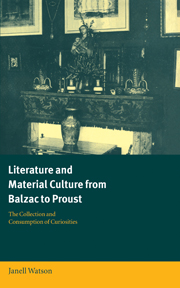Book contents
- Frontmatter
- Contents
- Acknowledgments
- Introduction
- Chapter 1 The bibelot
- Chapter 2 The logic(s) of material culture
- Chapter 3 The fashionable artistic interior
- Chapter 4 Flaubert's “musées reçus”
- Chapter 5 Narrate, describe, or catalogue?
- Chapter 6 The parlour of critical theory
- Chapter 7 Rearranging the Oedipus
- Notes
- Bibliography
- Index
- CAMBRIDGE STUDIES IN FRENCH
Chapter 2 - The logic(s) of material culture
Imitation, accumulation, and mobility
Published online by Cambridge University Press: 22 September 2009
- Frontmatter
- Contents
- Acknowledgments
- Introduction
- Chapter 1 The bibelot
- Chapter 2 The logic(s) of material culture
- Chapter 3 The fashionable artistic interior
- Chapter 4 Flaubert's “musées reçus”
- Chapter 5 Narrate, describe, or catalogue?
- Chapter 6 The parlour of critical theory
- Chapter 7 Rearranging the Oedipus
- Notes
- Bibliography
- Index
- CAMBRIDGE STUDIES IN FRENCH
Summary
To call an object a “bibelot” is to place it in a category, therefore to classify it. Categorizing and classifying are key steps in the processes of organizing and establishing order. And yet, as demonstrated in the previous chapter, the category “bibelot” is fraught with ambiguity, put to often contradictory uses as a result of the disparities among the items that the category includes. Complicating matters is the consideration that the category “bibelot” calls forth several networks of terms used to classify, describe, and evaluate the various objects included within it, terms from the lexicons of the fine arts, the decorative arts, interior decor, collecting, the souvenir, commerce, home economics, and more. If, as I have suggested, the creation of the category “bibelot” is part of a modern and modernizing reconfiguration, reorganization, and recodification of material culture necessitated by a multiplication of objects in daily life, then what kind of reorganization is this? What kind of logic can accommodate or even account for such a disorderly order?
Bourdieu's notion of the “logic of practice” can be usefully applied to the contradictions and ambiguities of the category “bibelot.” The “logic of practice” is to be understood in opposition to the logic of analysis used by modernist scholars such as anthropologists (in the structuralist tradition), sociologists (in the positivist tradition), or philosophers of art (in the Kantian tradition).
- Type
- Chapter
- Information
- Literature and Material Culture from Balzac to ProustThe Collection and Consumption of Curiosities, pp. 27 - 56Publisher: Cambridge University PressPrint publication year: 2000

